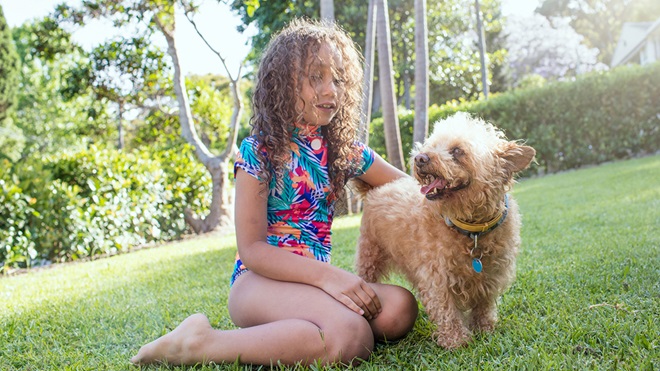Does your child sniffle and sneeze their way through the warmer months? While hayfever is more common in adults, up to seven percent of children in Australia are also affected and they account for the most hospital admissions.
With symptoms including sneezing, a runny or blocked nose, itchy, watery eyes and itchy throat, hayfever can affect sleep and mood, impacting on school and learning, and quality of life in general.
Meanwhile, for children with asthma, uncontrolled hayfever can bring on asthma attacks, while controlling allergies can help prevent asthma developing.
On this page:
- Hayfever treatment options for children
- Saline nasal irrigation
- Antihistamines
- Eye drops
- Immunotherapy
- Other treatments
Hayfever treatment options for children
Preventive measures are an important first line of treatment, which means identifying and avoiding the allergens causing the hayfever – for seasonal hayfever that's usually pollens, while pet hair and dust mites are common allergens for ongoing symptoms.
However, it's not always practical or possible to avoid allergens, leading parents to seek other treatment options. And hayfever management for adults isn't always appropriate for children.
The following treatments are considered suitable for children. Note that ages are those provided by manufacturers – in some situations, children younger than this may be recommended to take a particular medicine under medical supervision.
Saline nasal irrigation
As a first line of treatment, try saline nasal irrigation. It's inexpensive and in many cases effective, helping reduce runny nose, congestion, nasal itching and sneezing. It's the most gentle option, and suitable for babies from one month old. Try once a day, while bathing the child.
Kits for children are available at pharmacies, and contain a nasal irrigation bottle and sachets of pre-measured salt for mixing with warm water. A syringe or bulb applicator could be used instead, or you could buy ready-made spray.
Antihistamines
If saline nasal irrigation isn't helping, your next port of call is antihistamines – either oral (tablets, liquid or drops) or nasal spray.
Oral
Antihistamines in tablet or liquid form are good for managing a range of symptoms. However even the newer ones may leave kids a little drowsy, especially when they first start taking them. Headaches and stomach upsets are other side effects.
Cetirizine (for example, Zyrtec) and loratadine (for example, Claratyne) can be used in children from one year old, and fexofenadine (for example, Telfast) in children from two years for hayfever. Ask your pharmacist for products in forms and dosages appropriate for children.
Nasal spray
An antihistamine spray may be a better alternative for children five years or older – they act in the nasal passages, work faster than liquids (within 15 minutes) and last up to 12 hours. Their main downside is they can leave a bitter taste – using before a meal or flavoured drink could help. A bleeding nose, nausea and headache are other possible side effects.
Unlike antihistamine tablets and liquids, nasal sprays don't treat sore or itchy eyes – consider using eye drops if this is a problem (see below).
Azelastine (Azep) is suitable for children five years and older and can be used for up to six months uninterrupted. Levocabastine (Livostin and Zyrtec) can be used for children six and older for up to eight weeks.
Eye drops
For red, itchy or watery eyes associated with allergies, medicated eye drops can help.
Levocabastine (Zyrtec) eye drops are suitable for children six and older for up to eight weeks at a time, and help treat red, itchy and watery eyes. Azelastine is also available as eye drops (Eyezep), suitable for children four and older for use up to six weeks at a time.
Another type of eye drop is a decongestant and antihistamine combination – naphazoline hydrochloride and pheniramine maleate – found in Visine-A and Naphcon A. They can be used by children six and older, but only for a few days.
Immunotherapy
If your child's hayfever is so severe it dramatically impacts on their quality of life, your doctor may recommend immunotherapy. This means having allergy testing, then taking regular doses of the allergens that affect you, starting with very small doses and increasing over time.
For children, sublingual (tablets or drops under the tongue) are often used, mainly for their convenience – they can be taken at home. Injections – which are cheaper – are also used.
While it might not 'cure' hayfever, immunotherapy can relieve the severity of symptoms and reduce the need for other medication. Talk to your doctor about immunotherapy options.
Other treatments
If antihistamines don't help, corticosteroid nasal sprays may be worth trying, as long as your doctor agrees. They don't work as quickly as antihistamines – it could take hours rather than minutes. They're most effective when used regularly to maintain a steady dose over time, and reach maximum effectiveness after two to four weeks' use.
When nasal congestion is the primary symptom they have been shown to be more effective than antihistamines. However, side effects include nosebleeds, headaches and irritation of the nose and throat, and some nasal corticosteroids have been implicated in growth retardation in children.
Many over-the-counter products carry advice that they are not for children under 12, however, your doctor may recommend a suitable one for younger children, and prescribe directions for use.
Oral and nasal decongestants are not recommended for children.
We're on your side
For more than 60 years, we've been making a difference for Australian consumers. In that time, we've never taken ads or sponsorship.
Instead we're funded by members who value expert reviews and independent product testing.
With no self-interest behind our advice, you don't just buy smarter, you get the answers that you need.
You know without hesitation what's safe for you and your family.
And you'll never be alone when something goes wrong or a business treats you unfairly.
Learn more about CHOICE membership today
Stock images: Getty, unless otherwise stated.



